
Searching for Spring
Post Date
For some it’s the first pasque flower, the first day on open water or, Pre-COVID days, maybe it’s the first patio happy hour with friends. Whatever inspires your circadian calendar to invite spring and even thoughts of summer, I highly recommend adding morel mushrooms to the list.


Tips for first-time foragers!
- Be careful but don’t be intimidated. We don’t have too diverse of a fungus fauna here in North Dakota, and if you’re solely after the coveted morel mushroom, the only other similar species are false morels, which are poisonous but can easily be distinguished by their solid stem versus the hollow stem of a true morel.
- Dead, decayed and disturbed. Like most fungus and mushrooms, morels love dead and decaying organisms. East of here foragers are often advised to seek out dead elm trees, but box elders and cottonwoods can also be common hangouts for morels, as well as recently disturbed soil and sometimes in seemingly random places too. Keep your eyes peeled and often if you find one, there will be more. If/when you do, you’ll likely find success looking in other areas that are similar.
- Tuck your pants in. Prime morel season also happens to be prime tick season. Take precautions such as tucking your pants into your socks, wear repellent and thoroughly check for any hitchhikers afterwards.
- Paper not plastic. While picking and storing morels, use a recycled paper bag or even a netted bag like onions or lemons come in. This will prevent your precious harvest from getting smushed, soggy and decomposing, which happens quickly.
- Skip the soak. The morels you bring home will likely have dirt, sand and maybe even small bugs on them, so you’ll be tempted to wash them thoroughly, but they can quickly become waterlogged. It is best to lightly rinse them only when it’s time to cook.
- Fresh, frozen or dehydrated. You can cook your harvest right away that day or let them dry in a well-ventilated place for up to a week. If you want to savor your bounty throughout the year, you can dehydrate or freeze. (If vacuum-sealing frozen mushrooms I recommend slicing, then par-freezing before sealing so they don’t get smushed). Either way, do NOT eat morels raw!
Blog Category
Foraging



